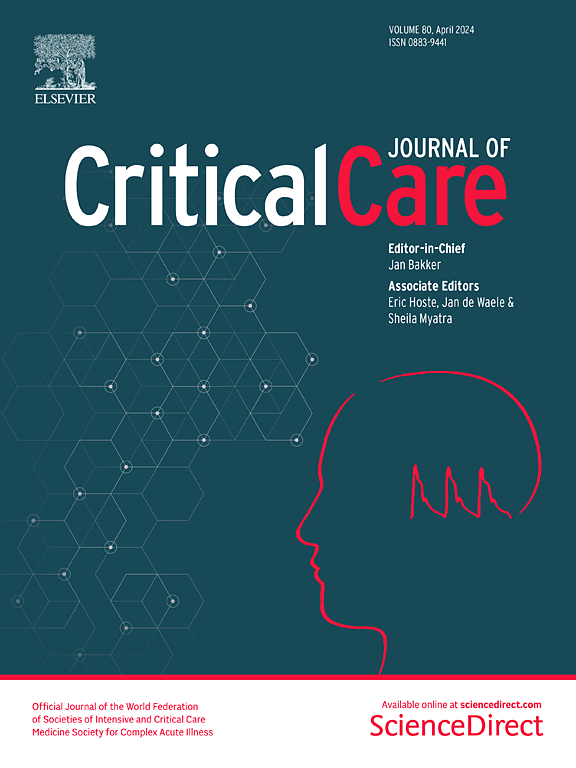如果呼气时间足够短,就能避免气道外伤:气道压力释放通气过程中的反向建模和振荡测量法提供的证据
IF 8.8
1区 医学
Q1 CRITICAL CARE MEDICINE
引用次数: 0
摘要
如果呼气时间较短,气道压力释放通气(APRV)对无呼吸道创伤有保护作用。我们假设,这种保护作用是因为上皮表面在呼气时没有足够的时间聚集和粘连,从而避免了在吸气时被迫分离造成的严重损伤。我们在吐温灌洗诱发 ARDS 的猪模型中研究了这一假设。根据吸气压力为 28 或 40 cmH2O,以及呼气末流量达到其初始峰值的 75%(呼气时间较短)或 25%(呼气时间较长)时是否终止呼气,将动物分为 4 组,分别进行 APRV 通气。我们根据吐温损伤后 6 小时内每小时获得的呼气和吸气时的气道压力-流量数据拟合了一个呼吸系统力学数学模型,该模型包括一个以参数 ${E}_{2}$$ 为特征的体积依赖性弹性项。我们还在相同的时间点通过吸气连续测量了 5 到 19 Hz 之间的呼吸系统阻抗,并由此得出了呼吸系统阻力($${R}_{rs}$$)的时间序列。呼气和吸气时的{E}_{2}$$在两个呼气时间较长的组别和两个呼气时间较短的组别之间存在显著差异(方差分析,p < 0.001)。我们发现,在接受较长呼气时间的较高压力组中,$${E}_{2}$$在吸气时受到的抑制最大,这表明$${E}_{2}$反映了肺实质的应变僵化与肺容量增加时的持续募集之间的平衡。我们还发现,在该组中,${R}_{rs}$$ 在吸气的前 0.5 秒逐渐增加,然后随着吸气的继续又开始减少。这些发现支持了这样的假设,即足够短的呼气持续时间可以防止出现肺不张,因为它们不会给减招足够的时间来表现出来。这为个性化调整机械通气提供了一种方法。本文章由计算机程序翻译,如有差异,请以英文原文为准。
Atelectrauma can be avoided if expiration is sufficiently brief: evidence from inverse modeling and oscillometry during airway pressure release ventilation
Airway pressure release ventilation (APRV) has been shown to be protective against atelectrauma if expirations are brief. We hypothesize that this is protective because epithelial surfaces are not given enough time to come together and adhere during expiration, thereby avoiding their highly damaging forced separation during inspiration. We investigated this hypothesis in a porcine model of ARDS induced by Tween lavage. Animals were ventilated with APRV in 4 groups based on whether inspiratory pressure was 28 or 40 cmH2O, and whether expiration was terminated when end-expiratory flow reached either 75% (a shorter expiration) or 25% (a longer expiration) of its initial peak value. A mathematical model of respiratory system mechanics that included a volume-dependent elastance term characterized by the parameter $${E}_{2}$$ was fit to airway pressure-flow data obtained each hour for 6 h post-Tween injury during both expiration and inspiration. We also measured respiratory system impedance between 5 and 19 Hz continuously through inspiration at the same time points from which we derived a time-course for respiratory system resistance ( $${R}_{rs}$$ ). $${E}_{2}$$ during both expiration and inspiration was significantly different between the two longer expiration versus the two shorter expiration groups (ANOVA, p < 0.001). We found that $${E}_{2}$$ was most depressed during inspiration in the higher-pressure group receiving the longer expiration, suggesting that $${E}_{2}$$ reflects a balance between strain stiffening of the lung parenchyma and ongoing recruitment as lung volume increases. We also found in this group that $${R}_{rs}$$ increased progressively during the first 0.5 s of inspiration and then began to decrease again as inspiration continued, which we interpret as corresponding to the point when continuing derecruitment was reversed by progressive lung inflation. These findings support the hypothesis that sufficiently short expiratory durations protect against atelectrauma because they do not give derecruitment enough time to manifest. This suggests a means for the personalized adjustment of mechanical ventilation.
求助全文
通过发布文献求助,成功后即可免费获取论文全文。
去求助
来源期刊

Critical Care
医学-危重病医学
CiteScore
20.60
自引率
3.30%
发文量
348
审稿时长
1.5 months
期刊介绍:
Critical Care is an esteemed international medical journal that undergoes a rigorous peer-review process to maintain its high quality standards. Its primary objective is to enhance the healthcare services offered to critically ill patients. To achieve this, the journal focuses on gathering, exchanging, disseminating, and endorsing evidence-based information that is highly relevant to intensivists. By doing so, Critical Care seeks to provide a thorough and inclusive examination of the intensive care field.
 求助内容:
求助内容: 应助结果提醒方式:
应助结果提醒方式:


